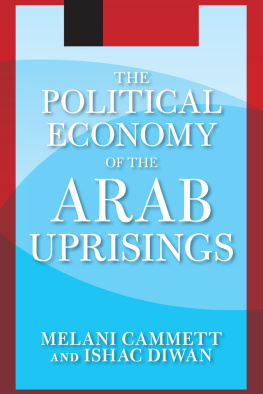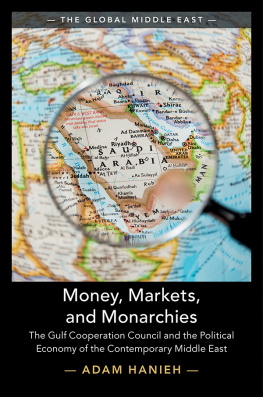Cammett Melani - A Political Economy of the Middle East
Here you can read online Cammett Melani - A Political Economy of the Middle East full text of the book (entire story) in english for free. Download pdf and epub, get meaning, cover and reviews about this ebook. publisher: Routledge, genre: Politics. Description of the work, (preface) as well as reviews are available. Best literature library LitArk.com created for fans of good reading and offers a wide selection of genres:
Romance novel
Science fiction
Adventure
Detective
Science
History
Home and family
Prose
Art
Politics
Computer
Non-fiction
Religion
Business
Children
Humor
Choose a favorite category and find really read worthwhile books. Enjoy immersion in the world of imagination, feel the emotions of the characters or learn something new for yourself, make an fascinating discovery.

- Book:A Political Economy of the Middle East
- Author:
- Publisher:Routledge
- Genre:
- Rating:5 / 5
- Favourites:Add to favourites
- Your mark:
- 100
- 1
- 2
- 3
- 4
- 5
A Political Economy of the Middle East: summary, description and annotation
We offer to read an annotation, description, summary or preface (depends on what the author of the book "A Political Economy of the Middle East" wrote himself). If you haven't found the necessary information about the book — write in the comments, we will try to find it.
A Political Economy of the Middle East — read online for free the complete book (whole text) full work
Below is the text of the book, divided by pages. System saving the place of the last page read, allows you to conveniently read the book "A Political Economy of the Middle East" online for free, without having to search again every time where you left off. Put a bookmark, and you can go to the page where you finished reading at any time.
Font size:
Interval:
Bookmark:




Westview Press was founded in 1975 in Boulder, Colorado, by notable publisher and intellectual Fred Praeger. Westview Press continues to publish scholarly titles and high-quality undergraduate and graduate-level textbooks in core social science disciplines. With books developed, written, and edited with the needs of serious nonfiction readers, professors, and students in mind, Westview Press honors its long history of publishing books that matter.
Copyright 2015 by Westview Press
Published by Westview Press,
A Member of the Perseus Books Group
2465 Central Avenue
Boulder, CO 80301
www.westviewpress.com
All rights reserved. Printed in the United States of America. No part of this book may be reproduced in any manner whatsoever without written permission except in the case of brief quotations embodied in critical articles and reviews. Every effort has been made to secure required permissions for all text, images, maps, and other art reprinted in this volume.
Westview Press books are available at special discounts for bulk purchases in the United States by corporations, institutions, and other organizations. For more information, please contact the Special Markets Department at the Perseus Books Group, 2300 Chestnut Street, Suite 200, Philadelphia, PA 19103, or call (800) 810-4145, ext. 5000, or e-mail .
Library of Congress Cataloging-in-Publication Data
Cammett, Melani Claire, 1969
A political economy of the Middle East / Melani Cammett, Brown University, Ishac Diwan, Harvard University, Alan Richards, University of California, Santa Cruz, Jo Waterbury, University of Beirut, NYU Abu Dhabi. Fourth edition.
pages cm
Includes bibliographical references and index.
ISBN 978-0-8133-4939-8 (e-book) 1. Middle EastEconomic conditions1979 2. Middle EastEconomic policy. 3. Working classMiddle East. 4. Middle EastPolitics and government1979 I. Diwan, Ishac. II. Richards, Alan, 1946 III. Richards, Alan, 1946 Political economy of the Middle East. IV. Title.
HC415.15.C36 2015
330.956dc23
2015001543
10 9 8 7 6 5 4 3 2 1
CONTENTS
TABLES
FIGURES
BOXES
The last edition of this book was published six years ago. In the interim, much has changed. First and foremost, the whole region has witnessed massive upheavals with the resurgence of the streetfirst in the Green Movement in Iran in 2009 and later with the Arab uprisings that began in Tunisia in December 2010 and spread across the region at greater or lesser levels of intensity, making a variety of societal demands on rulers. The authors of this book, too, have changed. The founding authors of this classic text, Alan Richards and Jo Waterbury, wrote the first three editions, which laid out an important agenda for the study of the region. We are privileged to take over co-authorship of the book, building on the excellent work of our predecessors and updating it to address the momentous shifts occurring in the Middle East. As we undertook this formidable task, we were struck by the prescience of many of the observations that Alan and Jo made at least two years before uprisings erupted across the region in 2011.
Since the third edition appeared, not only the region itself, but also Americans perceptions of and involvement in the region have undergone considerable change. Mass social mobilization in the Arab uprisings resulted in the ouster of some dictators (in Tunisia, Egypt, Libya, with the help of international intervention, and Yemen, although its deposed ruler retains significant influence in the country). Elsewhere, such as Bahrain, Jordan, and Morocco, large-scale social protests became the foundation of sustained opposition or pro-reform movements and have altered the nature of politics in enduring ways, even if incumbent rulers remain in place. In still other countries, demonstrations and similar forms of opposition did not occur on a mass scale, particularly in the oil-rich countries, which have small indigenous populations and rulers who can afford to respond to or preempt some citizen demands. Even in the OECD countries of the region, Israel and Turkey, large-scale social protests erupted, albeit in quite distinct political and economic contexts.
Meanwhile, some Middle Eastern countries are in the midst of protracted violent conflicts that are subjecting civilian populations to increasingly harsh living conditions and leading to sharp drops in human development achievements. In Iraq, state institutions continue to be weak while extremist Islamist groups are presently making territorial gains in the country and in neighboring Syria. Peaceful demonstrations against President Bashar al-Assad in Syria turned violent as the state cracked down harshly on protesters, and opposition forces have become increasingly dominated by extremist organizations. As in Iraq and elsewhere, the war in Syria has unraveled many impressive human development achievements and also spilled across borders, placing enormous pressures on neighboring countries such as Jordan and Lebanon. Libya is facing mounting unrest as government officials struggle to strengthen state institutions and control the national territory while nonstate actors exert virtually unchecked authority in many parts of the country. And in the summer of 2014, Palestine and Israel were engaged in yet another cycle of heavy violence that would leave more than 1,800 Gazans dead and thousands injured, with limited prospects for medical care in the overtaxed health care system, while more than 60 Israelis, mostly soldiers, were killed.
Other aspects of the region exhibit some continuity since the last edition of this book was published. The so-called War on Terror remains in full swing, even if US troops have been withdrawn from Iraq and Afghanistan, and the public debate about the appropriate role for the United States in the region persists, with much of it still ill informed. Public uneasiness with the largely military approaches of the United States to the region since 9/11 helps to explain the Obama administrations reluctance to fully engage in the crisis in Syria and other parts of the region. Heated debates among specialists and policymakers enumerate the pros and cons of more direct intervention in these conflicts. Despite these deep differences of opinion, most now agree that the problems of the bulk of the countries in the region are structural and deeply entrenched and therefore do not readily lend themselves to simple solutions, as Richards and Waterbury noted in these pages six years ago. Neither government officials, whether in the region or in the West, nor opposition groups, which at least until recently have been dominated by Islamists, have thus far identified and pursued viable strategies for leading the Middle East economies and societies down a path toward more inclusive and sustainable development.
In this edition of the book, as in previous editions, we aim to provide readers with an understanding of the complexity and depth of the regions challenges with respect to economic, social, and political development. In the introductory chapter, we present the framework of the book. We maintain that any attempt to understand the varied development trajectories within the region (or in any region) must start with politicsthe struggles over resources that ultimately produce the formal and informal rules in a given society. Yet politics does not operate in a vacuum: the decisions and actions of political actors, especially those in the state, are shaped by the demands and behavior of societal actors as well as by economic opportunities and limitations. Indeed, the nature of state institutions, the choices of state actors, the actions of individuals and groups in society, and economic trends and circumstances evolve in an interactive, mutually constitutive fashion.
Next pageFont size:
Interval:
Bookmark:
Similar books «A Political Economy of the Middle East»
Look at similar books to A Political Economy of the Middle East. We have selected literature similar in name and meaning in the hope of providing readers with more options to find new, interesting, not yet read works.
Discussion, reviews of the book A Political Economy of the Middle East and just readers' own opinions. Leave your comments, write what you think about the work, its meaning or the main characters. Specify what exactly you liked and what you didn't like, and why you think so.




